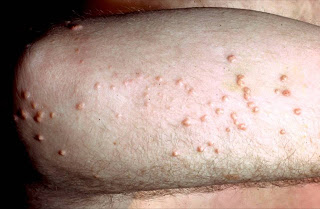
1. A 26-year-old man presents with a rash over his right arm and elbow for the past 4 months. It is not itchy. What is the SINGLE MOST likely underlying cause for this patient’s rash? Select ONE option only.
A. Alcohol excess
B. Coeliac disease
C. Human immunodeficiency virus (HIV) infection
D. Hyperthyroidism
E. Hypogonadism
Answer: A
This picture shows eruptive xanthomata which characteristically arise on the buttocks, elbows and knees. They typically occur in hypertriglyceridaemia and uncontrolled diabetes mellitus. Alcohol excess is a common cause of hypertriglyceridaemia.Coeliac disease may be associated with dermatitis herpetiformis – —a blistering rash which tends to affect extensor surfaces. It is typically very itchy.HIV infection per se would not cause this rash, but some anti-retroviral drugs used in the management of HIV infection can cause dyslipidaemia as a side- effect. This rash may be mistaken for molluscum contagiosum which can occur in HIV and acquired immune deficiency syndrome (AIDS).
2. In the assessment of cardiovascular disease risk, if the patient is a man of South Indian origin, by what factor is his risk increased?
A. ×1.2
B. ×1.4
C. ×1.5
D. ×2
E. ×2.5
F. ×3
G. ×3.5
H. ×4
I. ×4.5
J. ×5
Answer: B
3. In the assessment of cardiovascular disease risk, if the patient has ONE first-degree relative with a history of premature coronary heart disease, by what factor is their risk increased?
A. ×1.2
B. ×1.4
C. ×1.5
D. ×2
E. ×2.5
F. ×3
G. ×3.5
H. ×4
I. ×4.5
J. ×5
Answer: C
4. In the assessment of cardiovascular disease risk, if the patient has TWO OR MORE first-degree relatives with a history of premature coronary heart disease, by what factor is their risk increased?
A. ×1.2
B. ×1.4
C. ×1.5
D. ×2
E. ×2.5
F. ×3
G. ×3.5
H. ×4
I. ×4.5
J. ×5
Answer: D
NICE clinical guideline 67 (May 2008) Lipid Modification gives full details of how to assess and calculate cardiovascular disease risk.
5. In the treatment of hyperlipidaemia, statin therapy should be discontinued if serum transaminases are raised by more than what factor above the upper limit of normal?
A. ×1.2
B. ×1.4
C. ×1.5
D. ×2
E. ×2.5
F. ×3
G. ×3.5
H. ×4
I. ×4.5
J. ×5
Answer: F
6.
In the treatment of hyperlipidaemia, statin therapy should be discontinued if myopathy is suspected and creatine kinase is elevated by more than what factor above the upper limit of normal? [Show Discussion]
A. ×1.2
B. ×1.4
C. ×1.5
D. ×2
E. ×2.5
F. ×3
G. ×3.5
H. ×4
I. ×4.5
J. ×5
Answer: J
The BNF has an excellent section on lipid-regulating drugs, including the use of statins (HMG CoA reductase inhibitors), their cautions and side-effects.Caution should be exercised when prescribing statins to those with liver disease and/or a history of alcohol excess.Hypothyroidism should be adequately treated before assessing the need for lipid-regulating treatment. Treating hypothyroidism can potentially correct the dyslipidaemia. In addition, hypothyroidism increases the risk of myositis with concomitant lipid-regulating therapy.
No comments:
Post a Comment